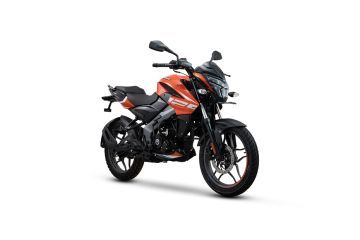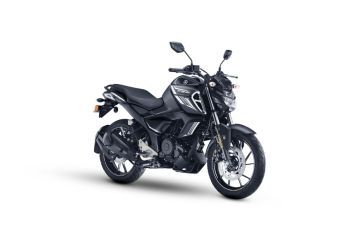Explore all New Cars of 2025
Bajaj Pulsar NS 125 vs Yamaha FZS-FI V3
Pulsar NS 125 vs FZS-FI V3
| Key Highlights | Pulsar NS 125 STD | FZS-FI V3 Matte Red And Matte Grey |
|---|---|---|
| Engine Type | 4-Stroke, SOHC 4-Valve, Air Cooled, BSVI Compliant DTS-i Ei Engine | Air cooled, 4-stroke, SOHC, 2-valve |
| Max Power | 12 PS @ 8500 rpm | 12.4 PS @ 7250 rpm |
-
Bajaj Pulsar NS 125
 Rs. 1.01 Lakh EMI - Rs. 3,020 View January OffersYamaha FZS-FI V3
Rs. 1.01 Lakh EMI - Rs. 3,020 View January OffersYamaha FZS-FI V3 Rs. 1.22 Lakh EMI - Rs. 3,541 View January Offers
Rs. 1.22 Lakh EMI - Rs. 3,541 View January Offers
Pulsar NS 125 vs FZS-FI V3 Key Highlights
| Basic Info | Bajaj Pulsar NS 125 STD | Yamaha FZS-FI V3 Matte Red And Matte Grey |
|---|---|---|
| Rating |
386 reviews
|
534 reviews
|
| Brand Name | Bajaj | Yamaha |
| Ex-Showroom Price | Rs. 1.01 Lakh Get On-Road Price | Rs. 1.22 Lakh Get On-Road Price |
| Engine Type | 4-Stroke, SOHC 4-Valve, Air Cooled, BSVI Compliant DTS-i Ei Engine | Air cooled, 4-stroke, SOHC, 2-valve |
| Max Power | 12 PS @ 8500 rpm | 12.4 PS @ 7250 rpm |
| Fuel Type | Petrol | Petrol |
| Colors | ||
| Brakes Front | Disc | Disc |
| Brakes Rear | Drum | Disc |
| Braking Type | Combi Brake System | ... |
| Wheel Size | Front :-431.8 mm,Rear :-431.8 mm | Front :-431.8 mm,Rear :-431.8 mm |
| Wheels Type (Pressed Steel/ Alloy) | Alloy | Alloy |
| ABS | ... | Single Channel |
| Starting | Kick and Self Start | Self Start Only |
| Speedometer | Digital | Digital |
| EMI |
Rs. 3,020
@
11.99% (36 months)
|
Rs. 3,541
@
9.45% (36 months)
|
| Insurance | Rs. 6,696 Pulsar NS 125 Insurance | Rs. 7,161 FZS-FI V3 Insurance |
| Brochure | N/A |
Download
Brochure
|
Engine |
|
||||||||||||||||||||||||||||||||||||||||||||||||||||||||||||
|---|---|---|---|---|---|---|---|---|---|---|---|---|---|---|---|---|---|---|---|---|---|---|---|---|---|---|---|---|---|---|---|---|---|---|---|---|---|---|---|---|---|---|---|---|---|---|---|---|---|---|---|---|---|---|---|---|---|---|---|---|---|
Brakes |
|
||||||||||||||||||||||||||||||||||||||||||||||||||||||||||||
Performance |
|
||||||||||||||||||||||||||||||||||||||||||||||||||||||||||||
Tyres |
|
||||||||||||||||||||||||||||||||||||||||||||||||||||||||||||
Dimensions |
|
||||||||||||||||||||||||||||||||||||||||||||||||||||||||||||
Electricals |
|
||||||||||||||||||||||||||||||||||||||||||||||||||||||||||||
Features |
|
Pros and Cons
- Positives
- Negatives
- Big bike styling
- features
- smooth engine.
- Performance isn’t up to the mark
- the quality of plastics feels sub-par.
Is Bajaj Pulsar NS 125 Better Than Yamaha FZS-FI V3?
60% users have chosen Bajaj Pulsar NS 125 over Yamaha FZS-FI V3 in a survey being conducted on zigwheels.com.
Apart from this survey a total of 2327 users have also rated Bajaj Pulsar NS 125 and Yamaha FZS-FI V3 on some really important factors like Mileage , performance, comfort, safety etc. and have given their personal opinions about these bikes.
As per the users experiences Bajaj Pulsar NS 125 is a winner for you if you are seriously looking for performance, maintenance and features in your bike. But Yamaha FZS-FI V3 is better on the grounds of mileage and comfort.
Before making your decision you should also consider the unbiased and thorough analysis of these bikes on every aspect by our auto experts who have summarised the analysis in pros, cons and final conclusion..
| Ratings Factor | Pulsar NS 125 | FZS-FI V3 |
|---|---|---|
| Mileage | 4.2 | 4.3 |
| Performance | 4.3 | 4.2 |
| Comfort | 4.2 | 4.4 |
| Maintenance | 4.0 | 3.8 |
| Features | 4.4 | 4.3 |
Videos of Bajaj Pulsar NS 125 and Yamaha FZS-FI V3
-
Bajaj Pulsar NS 125 | Road Test Review | Best Sporty 125cc On Sale? 20 Jul, 2021 24713 views
-
Bajaj Pulsar NS125 Walkaround | One More Pulsar? What Does It Get? | ZigWheels.com 9 Jun, 2021 15947 views
-
Traction Control For Yamaha FZ-S Fi Version 4.0, FZ-X, R15 M, MT-15 V2 | Price & Features | Zigwheels 14 Feb, 2023 8908 views
Bajaj Pulsar NS 125 Comparison with Similar Bikes
yamaha fz s fi version 3 Comparison with Similar Bikes
-
 YamahaFZS-FI V3Rs. 1.22 LakhvsFZS-FI V3 vs Apache RTR 160 4V
YamahaFZS-FI V3Rs. 1.22 LakhvsFZS-FI V3 vs Apache RTR 160 4V TVSApache RTR 160 4VRs. 1.24 Lakh
TVSApache RTR 160 4VRs. 1.24 Lakh -
 YamahaFZS-FI V3Rs. 1.22 LakhvsFZS-FI V3 vs FZ-FI Version 3.0
YamahaFZS-FI V3Rs. 1.22 LakhvsFZS-FI V3 vs FZ-FI Version 3.0 YamahaFZ-FI Version 3.0Rs. 1.17 Lakh
YamahaFZ-FI Version 3.0Rs. 1.17 Lakh
Latest News on Bajaj Pulsar NS 125 and Yamaha FZS-FI V3
-
 Bajaj Pulsar NS125 vs Hero Xtreme 125R vs TVS Raider 125 vs Honda SP125: Specification Comparison8 Mar, 2024 | By Team ZigWheels
Bajaj Pulsar NS125 vs Hero Xtreme 125R vs TVS Raider 125 vs Honda SP125: Specification Comparison8 Mar, 2024 | By Team ZigWheels -
 Yamaha Announces Festive Offers For FZ-Fi, FZ-S Fi V3 and V4, Fascino And RayZR 125 Fi Hybrid26 Sep, 2024 | By Team ZigWheels
Yamaha Announces Festive Offers For FZ-Fi, FZ-S Fi V3 and V4, Fascino And RayZR 125 Fi Hybrid26 Sep, 2024 | By Team ZigWheels -
 2024 Bajaj Pulsar NS125 Launched At Rs 1.04 Lakh28 Feb, 2024 | By Team ZigWheels
2024 Bajaj Pulsar NS125 Launched At Rs 1.04 Lakh28 Feb, 2024 | By Team ZigWheels -
 Yamaha FZ-S FI V4 vs TVS Apache RTR 160: Features Compared20 Feb, 2023 | By Team ZigWheels
Yamaha FZ-S FI V4 vs TVS Apache RTR 160: Features Compared20 Feb, 2023 | By Team ZigWheels -
 Best-Selling Bikes In India Between Rs 1-2 Lakh For June 202218 Jul, 2022 | By Team ZigWheels
Best-Selling Bikes In India Between Rs 1-2 Lakh For June 202218 Jul, 2022 | By Team ZigWheels -
 Yamaha FZ-S V4 Vs FZ-S V3: New Vs Old In 5 Pics13 Feb, 2023 | By Team ZigWheels
Yamaha FZ-S V4 Vs FZ-S V3: New Vs Old In 5 Pics13 Feb, 2023 | By Team ZigWheels -
 Bajaj’s Baby Streetfighter Reviewed Through Images25 Jul, 2021 | By Team ZigWheels
Bajaj’s Baby Streetfighter Reviewed Through Images25 Jul, 2021 | By Team ZigWheels -
 Alcohol-guzzling Bikes Showcased at Auto Expo13 Jan, 2023 | By Team ZigWheels
Alcohol-guzzling Bikes Showcased at Auto Expo13 Jan, 2023 | By Team ZigWheels -
 A Closer Look At Bajaj’s Baby NS In The Flesh11 Jun, 2021 | By Team ZigWheels
A Closer Look At Bajaj’s Baby NS In The Flesh11 Jun, 2021 | By Team ZigWheels -
 Key Highlights Of The 2022 Yamaha FZ-S Version 3.05 Jan, 2022 | By Team ZigWheels
Key Highlights Of The 2022 Yamaha FZ-S Version 3.05 Jan, 2022 | By Team ZigWheels
Recently Asked User Questions
- The Bajaj Pulsar NS125 packs a peppy engine, is fun to ride, and could be the perfect beginner bike for you. The entry-level NS125 could be the perfect platform for those graduating from a scooter, and yearning to learn the ropes. On the other hand, TVS Raider's styling, features and performance will excite youngsters, and for someone looking at their first motorcycle, the Raider does make good sense. TVS has gone the smarter route, keeping a thrilling ride experience as the USP, instead of a purely commuter-centric approach. Moreover, we would suggest you to take a test ride before making the final decision. Follow the link and select your city and brand accordingly for dealership details.
- Both the bikes are good in their forte. In nearly every aspect, except maybe ergonomics and braking, the Yamaha FZS-FI v3.0 fails to impress. While its motor offers better fuel efficiency compared to the previous-gen model, it lacks grunt. If you have around Rs 1 lakh to invest, you're better off with say a TVS Apache RTR 160 4V, Bajaj Pulsar NS 160 or the Suzuki Gixxer. Whereas, the Yamaha MT 15 BS6 is more than just the R15 v3 sans fairing. The naked looks sharp is light and can be a hoot to commute. However, the compact riding posture might be a bit too tight for large riders. What is also disheartening is the poor switchgear and build quality as well as the lack of dual-channel ABS. Moreover, we would suggest you to take a test ride for a better understanding of performance and comfort. Click on the link and select your desired city for dealership details.
- Selecting the right bike would depend on several factors such as your budget preference on the segment, features required, engine options, brand preference, etc. In nearly every aspect, except maybe ergonomics and braking, the Yamaha FZS-FI v3.0 fails to impress. While its motor offers better fuel efficiency compared to the previous-gen model, it lacks grunt. If you have around Rs 1 lakh to invest, you're better off with say a TVS Apache RTR 160 4V, Bajaj Pulsar NS 160, or the Suzuki Gixxer. Yamaha FZS-FI V3 is powered by a 149 cc engine. This FZS-FI V3 engine generates a power of 12.4 PS @ 7250 rpm and a torque of 13.3 Nm @ 5500 rpm. The claimed mileage of FZS-FI V3 is 55.42 kmpl. On the other hand, The TVS Apache RTR 160 4V has been the benchmark when it comes to 160cc motorcycles. With the BS6-compliant iteration, TVS has made sure it is still as sprightly, with the '21 update making it the most powerful bike in the 160cc sporty commuter class. The overall package and reasonable pricing make it a true value-for-money motorcycle in its segment. TVS Apache RTR 160 4V is powered by a 159.7 cc engine. This Apache 160 4V engine generates a power of 17.63 PS @ 9250 rpm and a torque of 14.73 Nm @ 7250 rpm. Moreover, we would suggest you to take a test ride before making the final decision. Follow the link and select your desired city for dealership.

















